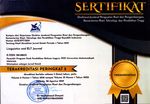The Students and Teacher’s Perception of Mobile-Assisted Language Learning Integration in EFL Teaching-Learning Practices
Abstract
In the ever-evolving landscape of language education, technology propelled people toward new horizons, acting as the wind in their sails. Mobile-Assisted Language Learning (MALL) stood at the helm of this digital voyage, reshaping how people acquired languages. When setting these targets, the researcher focused on considering the quality requirements of mobile applications, taking into account the perspectives of both users and instructors. Therefore, the study aimed to analyze students' and teachers' perceptions of MALL integration in teaching-learning practice. For this study, the researcher chose a descriptive qualitative approach. The researcher used a questionnaire and an interview to collect both quantitative and qualitative data perspectives. The researcher quantitatively presented the percentage data of the questionnaire, and qualitatively, an analysis of interview responses was conducted, obtained from three classes and a teacher from one of the Private Junior High Schools in Jakarta. In a quantitative data perspective, students demonstrated favorable ratings on measures of usefulness, ease of use, and satisfaction when utilizing MALL (Mobile-Assisted Language Learning) in their English classrooms, as indicated by responses collected through Google Forms. From a qualitative perspective, both teachers and students concurred that MALL held the potential for enhancing both soft and hard skills. It fostered learning focus and independent study, offered convenience through its availability anytime and anywhere, optimized battery and data consumption, and facilitated communication between students and teachers. The result was an expressed desire to utilize MALL in the future.
Keywords
Full Text:
PDFReferences
J. W. Creswell, “Educational research: Planning, conducting, and evaluating quantitative and qualitative research,” Educational Research, vol. 4. 2012.
P. S. Hidayati and A. Rosyid, “PEMBELAJARAN ENGLISH PRONUNCIATION MELALUI MOBILE ASSISTED LANGUAGE LEARNING (MALL): POTENSI DAN HAMBATAN,” Pedago. J. Ilm. Pendidik., vol. 4, no. 2, 2020, doi: 10.33751/pedagonal.v4i2.2524.
M. Mortazavi, M. K. M. Nasution, F. Abdolahzadeh, M. Behroozi, and A. Davarpanah, “Sustainable learning environment by mobile-assisted language learning methods on the improvement of productive and receptive foreign language skills: A comparative study for asian universities,” Sustain., vol. 13, no. 11, 2021, doi: 10.3390/su13116328.
N. Anggrarini and I. Yulianawati, “EXPLORING MOBILE APPLICATION AND THEIR USAGE IN ENGLISH LANGUAGE LEARNING,” Wiralodra English J., vol. 4, no. 2, 2020, doi: 10.31943/wej.v4i2.112.
R.-A. Pilar, A. Jorge, and C. Cristina, “The Use of Current Mobile Learning Applications in EFL,” Procedia - Soc. Behav. Sci., vol. 103, 2013, doi: 10.1016/j.sbspro.2013.10.446.
R. A. Yudhiantara and A. Saehu, “Mobile-Assisted Language Learning (MALL) in Indonesian Islamic Higher Education,” IJELTAL (Indonesian J. English Lang. Teach. Appl. Linguist., vol. 2, no. 1, 2017, doi: 10.21093/ijeltal.v2i1.52.
R. A. Yudhiantara and H. Sugilar, “MENUJU IMPLEMENTASI MOBILE ASSISTED LAGUAGE LEARNING (MALL): PENGGUNAAN SMART PHONE UNTUK PEMBELAJARAN KAMUS MONOLINGUAL BAHASA INGGRIS,” J. Perspekt., vol. 1, no. 2, 2018, doi: 10.15575/jp.v1i2.9.
S. Habib, A. Haider, S. S. M. Suleman, S. Akmal, and M. A. Khan, “Mobile Assisted Language Learning: Evaluation of Accessibility, Adoption, and Perceived Outcome among Students of Higher Education,” Electron., vol. 11, no. 7, Apr. 2022, doi: 10.3390/electronics11071113.
H. Oz, “An investigation of preservice english teachers’ perceptions of mobile assisted language learning,” English Lang. Teach., vol. 8, no. 2, 2015, doi: 10.5539/elt.v8n2p22.
A. H. Miqawati, “PRONUNCIATION LEARNING, PARTICIPATION, AND ATTITUDE ENHANCEMENT THROUGH MOBILE ASSISTED LANGUAGE LEARNING (MALL),” English Rev. J. English Educ., vol. 8, no. 2, 2020, doi: 10.25134/erjee.v8i2.2118.
C. Nuraeni, I. Carolina, A. Supriyatna, W. Widiati, and S. Bahri, “Mobile-Assisted Language Learning (MALL): Students’ Perception and Problems towards Mobile Learning in English Language,” in Journal of Physics: Conference Series, 2020, vol. 1641, no. 1. doi: 10.1088/1742-6596/1641/1/012027.
H. Haryadi, S and A. Aprianoto, “INTEGRATING ‘ENGLISH PRONUNCIATION’ APP INTO PRONUNCIATION TEACHING: HOW IT AFFECTS STUDENTS’ PARTICIPATION AND LEARNING,” J. Lang. Lang. Teach., vol. 8, no. 2, 2020, doi: 10.33394/jollt.v8i2.2551.
C. Nuraeni, “Maximizing Mobile-Assisted Language Learning (MALL) amid Covid-19 Pandemic: Teachers’ Perception,” Metathesis J. English Lang. Lit. Teach., vol. 5, no. 1, 2021, doi: 10.31002/metathesis.v5i1.3336.
Z. C. Aratusa, “Students’ Perceptions on the Use of Mobile-Assisted Language Learning (MALL) in Learning Pronunciation,” Int. J. Curr. Sci. Res. Rev., vol. 05, no. 07, Jul. 2022, doi: 10.47191/ijcsrr/V5-i7-50.
J. Kyakuwa, “It Piques a Novice’s Curiosity and Engages the Experienced: A Review of Designing Qualitative Research (The SAGE Qualitative Research Kit),” Qual. Rep., 2019, doi: 10.46743/2160-3715/2019.4337.
C. Milford et al., “Teamwork in Qualitative Research: Descriptions of a Multicountry Team Approach,” Int. J. Qual. Methods, vol. 16, no. 1, 2017, doi: 10.1177/1609406917727189.
Lin, “Learning English reading in a mobile-assisted extensive reading program,” Comput. Educ., vol. 78, pp. 48–59, 2014, doi: http://dx.doi.org/10.1016/j.compedu.2014.05.004.
S. Yuliani, “Role of Mobile Phone for English Language Teaching,” J-SHMIC J. English Acad., vol. 6, no. 1, 2019, doi: 10.25299/jshmic.2019.vol6(1).2668.
P. T. Tra, “MOBILE-ASSISTED LANGUAGE LEARNING IN A UNIVERSITY CONTEXT IN VIETNAM: STUDENTS’ ATTITUDES,” VNU J. Foreign Stud., vol. 36, no. 1, 2020, doi: 10.25073/2525-2445/vnufs.4502.
W. U. A. Wan Azli, P. M. Shah, and M. Mohamad, “Perception on the Usage of Mobile Assisted Language Learning (MALL) in English as a Second Language (ESL) Learning among Vocational College Students,” Creat. Educ., vol. 09, no. 01, 2018, doi: 10.4236/ce.2018.91008.
B. Biantoro, “EXPLORING THE INTEGRATIONS OF MALL INTO ENGLISH TEACHING AND LEARNING FOR INDONESIAN EFL STUDENTS IN SECONDARY SCHOOLS,” Celt. A J. Cult. English Lang. Teaching, Lit. Linguist., vol. 7, no. 2, 2020, doi: 10.22219/celtic.v7i2.14090.
K. E. Gael and D. S. Elmiana, “Mobile-Assisted Language Learning (MALL) in English language acquisition: a critical literature review,” JELTIM (Journal English Lang. Teach. Innov. Mater., vol. 3, no. 2, 2021, doi: 10.26418/jeltim.v3i2.49813.
R. Dwigustini, N. Sari, S. Susilawati, and B. Nisa, “FOSTERING STUDENTS’ WRITING SKILL BY THE INTEGRATION OF MALL APPLICATION,” J. Lang. Lang. Teach., vol. 9, no. 1, 2021, doi: 10.33394/jollt.v9i1.3264.
M. N. L. Wagner, M. V. Donskaya, M. E. Kupriyanova, and U. A. Ovezova, “Perspectives of introduction of the mobile-assisted language learning (Mall) technology,” Int. J. Environ. Sci. Educ., vol. 11, no. 15, 2016.
T. M. Miangah, “Mobile-Assisted Language Learning,” Int. J. Distrib. Parallel Syst., vol. 3, no. 1, pp. 309–319, Jan. 2012, doi: 10.5121/ijdps.2012.3126.
A. T. Ibrohim, A. Septianti, and I. S. Sadikin, “STUDENTS’ PERCEPTION TOWARD TEACHING ENGLISH VOCABULARY THROUGH TOTAL PHYSICAL RESPONSE (TPR) METHOD,” Proj. (Professional J. English Educ., vol. 1, no. 2, 2019, doi: 10.22460/project.v1i2.p145-156.
J. Hindratno, M. Meitiana, and Y. Manurung, “Pengaruh Budaya, Persepsi, dan Kepercayaan Terhadap Keputusan Pembelian Obat Tradisional di UKM Pasar Kahayan Kota Palangka Raya,” JEMBA J. Ekon. Pembangunan, Manaj. dan bisnis, Akunt., vol. 1, no. 1, 2021, doi: 10.52300/jemba.v1i1.2487.
A. D. H. Ningrum and F. I. Arrasyid, “STUDENTS’ PERCEPTIONS TOWARDS THE IMPLEMENTATION OF MALL IN ENGLISH LEARNING: A CASE IN SENIOR HIGH SCHOOL,” ELLTER J., vol. 2, no. 1, 2021, doi: 10.22236/ellter.v2i1.6243.
M. Ahya, S. Ahmad, and Y. Fitriani, “The Role of Principal and Teacher Leadership to Improve the Quality of Learning in SMA Negeri 5 OKU,” Edunesia J. Ilm. Pendidik., vol. 2, no. 2, 2021, doi: 10.51276/edu.v2i2.134.
I. Alrefaai, “Exploring EFL Graduate Students’ Attitudes toward, and Use of, Mobile Phones in Language Learning,” Arab World English J., no. 1, 2019, doi: 10.24093/awej/efl1.6.
T. Suhair and A. Abdulameer, “The Role of Mobile Assisted Language Learning in Improving the Pronunciation of Students of English in the College of Education for Women at Al-Iraqia University,” 2021.
M. Hashemi and B. Ghasemi, “Using mobile phones in language learning/teaching,” in Procedia - Social and Behavioral Sciences, 2011, vol. 15. doi: 10.1016/j.sbspro.2011.04.220.
H. Syofyan, “Analisis Gaya Belajar dan Motivasi Berprestasi terhadap Hasil Belajar IPA,” J. Eduscience, vol. 3, no. 2, 2018.
A. Niño, “Language Learners Perceptions and Experiences on the Use of Mobile Applications for Independent Language Learning in Higher Education,” IAFOR J. Educ., vol. 3, no. SE, 2015, doi: 10.22492/ije.3.se.05.
I. S. Sadikin, S. Lestari, and S. Aini, “Pembelajaran Daring Interaktif, Bermakna dan Menarik sebagai Upaya Optimalisasi Proses Pembelajaran masa Pandemi Covid-19,” J. Pengabdi. Pada Masy., vol. 5, no. 4, 2020, doi: 10.30653/002.202054.647.
DOI: https://doi.org/10.31764/leltj.v11i2.19538
Refbacks
- There are currently no refbacks.
Copyright (c) 2023 Irma Savitri Sadikin

This work is licensed under a Creative Commons Attribution-ShareAlike 4.0 International License.
_____________________________________________________
Linguistics and ELT Journal
p-ISSN 2339-2940 | e-ISSN 2614-8633

LELTJ is licensed under a Creative Commons Attribution-ShareAlike 4.0 International License.
_____________________________________________________
LELTJ is abstracting & indexing in the following databases:
_____________________________________________________
LELTJ Editorial Office:













